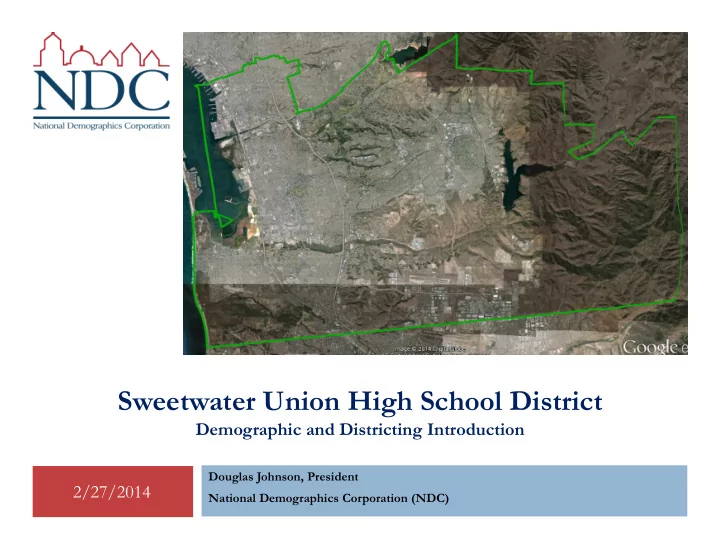

Sweetwater Union High School District Demographic and Districting Introduction Douglas Johnson, President 2/27/2014 National Demographics Corporation (NDC)
age0-19 30% Age age20-60 55% age60plus 14% Immigration immigrants 33% vacant 9% 2 occupied 91% rented 46% Housing Stats District owned 54% singlefamily 67% General multifamily 33% english 36% Language spoken at Demographics spanish 47% home asian-lang 9% Children at Home child-under18 40% 2008 – 2012 American Community Survey Data employed 54% Work (percent of Commute on Public pop age 16+) 5% Transit hhincome0-25k 21% hhincome25-50k 23% Household Income hhincome50-75k 18% hhincome75-200k 35% hhincome200k-plus 3% hs-grad 55% Education (among bachelor 15% those age 25+) graduatedegree 7% 2/27/2014
District Demographics: Total Pop. 3 Total Population (2010 Census) Category Count Percentage 455,078 Total 279,059 61% Hispanic 83,874 18% Non-Hispanic White 20,541 5% Non-Hispanic Black 1,859 0% Non-Hispanic Native American 63,082 14% Non-Hispanic Asian American 2,522 1% Non-Hispanic Pacific Islander 925 0% Non-Hispanic Other 3,216 1% Non-Hispanic Other Multi-Race All multi-racial responses were tabulated using the methodology suggested by the U.S. Department of Justice and Office of Management & Budget 2/27/2014
District Demographics: Voting Age Pop. 4 Voting Age Population (2010 Census) Category Count Percentage Total 332,037 Hispanic 189,945 57% Non-Hispanic White 71,720 22% Non-Hispanic Black 15,749 5% Non-Hispanic Native American 1,498 0% Non-Hispanic Asian American 48,680 15% Non-Hispanic Pacific Islander 1,964 1% Non-Hispanic Other 638 0% Non-Hispanic Other Multi-Race 1,843 1% All multi-racial responses were tabulated using the methodology suggested by the U.S. Department of Justice and Office of Management & Budget 2/27/2014
District Demographics: CVAP 5 Citizens of Voting Age Population (2008-2012 American Community Survey) Category Count Percentage Total 267,045 Hispanic 136,631 51% Non-Hispanic White 69,789 26% Non-Hispanic Black 15,466 6% Non-Hispanic Native American 952 0% Non-Hispanic Asian American 37,113 14% Non-Hispanic Pacific Islander 1,321 0% Non-Hispanic Other 5,423 2% All multi-racial responses were tabulated using the methodology suggested by the U.S. Department of Justice and Office of Management & Budget 2/27/2014
District Demographics: Surnames 6 Spanish-Surname Voter Registration (2010 General Election data from the California Statewide Database) Category Count/Estimate Total 175,758 Hispanic 50% Asian American 1% We are currently updating our data to incorporate the latest Filipino 5% Statewide Database 2012 data. Spanish-Surname Voter Turnout (2010 General Election data from the California Statewide Database) Category Count/Estimate Total 94,712 Hispanic 43% Asian American 1% Filipino 47% 2/27/2014
Latino Summary 7 Hispanic Population 61 % of total population 57 % of voting age population 51 % of Citizen Voting Age Population 50 % of registered voters in 2010 General election 43 % of voter turnout in the 2010 General election Data Sources: 2010 Census, 2006-2010 American Community Survey (ACS), and California Statewide Database. 2/27/2014
High School Graduates (Among Population over 25) 8 2/27/2014
Latino Citizen Voting Age Population 9 2/27/2014
Asian-American CVAP 10 2/27/2014
Drawing Trustee Areas 11 2/27/2014
Process 12 Review Criteria 1. Draft Plans 2. Public Hearing on Draft Plans 3. Committee consideration of Draft Plans 4. Committee adoption of a Final Plan 5. State Board of Education Approval of Election Waiver 6. 2/27/2014
Required Criteria: Federal Laws 13 Population Equality among trustee areas Total population: not voting age population, citizens, or voters “Substantial equality” – Total deviation up to 10% is presumptively constitutional. 10% is not, however, a “safe harbor” – deviation must be justified by “legitimate considerations incident to the effectuation of a rational state policy.” Federal Voting Rights Act Compliance with Section 2: Ensure equal power to elect candidates of choice “Protected Class” populations must have an “equal opportunity to elect the candidates of their choice” No “packing” or “cracking” No racial gerrymandering Race may not be the “predominate” factor Focus on communities and neighborhoods, not race/ethnicity 2/27/2014
Traditional Redistricting Criteria 14 Listed in the California Elections Code: Topography Geography Cohesiveness, contiguity, integrity, & compactness of territory Community of interests Definition of a Community of interest Neighborhoods, especially school attendance areas, are common communities of interest in districting. Community should also indicate whether their preference is to be kept united (the most common view), or have a voice in multiple trustee areas? 2/27/2014
Additional Allowed Criteria 15 From Various Court Rulings: Respecting the boundaries of political subdivisions ( e.g. , school attendance areas, city boundaries, precinct boundaries, etc.). Use of whole census geography ( e.g. , census blocks). Avoiding head-to-head contests between incumbents. Anticipating future population shifts. 2/27/2014
Allowed and Banned Considerations 16 Discretionary Criteria: Consistent with the required criteria, individual districts may establish other criteria to address unique local concerns. Forbidden Considerations: May not use race as “predominant” factor, unless there is a “compelling state interest.” 2/27/2014
Next Steps & Public Input 17 Initial Steps: Direction on any changes to criteria NDC will draw initial draft plans (public input welcome) Public hearing on draft plans Public Input is highly encouraged: Public input is important and welcomed at every stage At any time: call, write, or email any thoughts, suggestions or draft plans Attend public hearing Attend Board meeting Attend County Committee meeting 2/27/2014
Recommend
More recommend